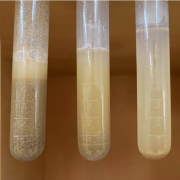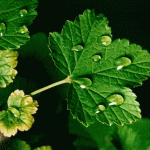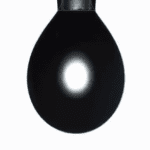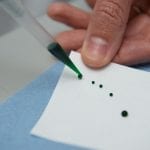
The Centre for Industrial Rheology provides physical characterisation services for the agrochemical industry including viscosity, rheology, surface tension, and contact angle analyses. The rheology of agrochemicals such as pesticides, crop protection chemicals, fertilizers, acidifying agents and liming agents are vital for creating formulations that are stable under storage, stable when diluted, easy to disperse and easy to dispense. We can quantify physical properties such as zero shear viscosity, high shear viscosity, surface tension, interfacial tension, hydrophobicity, and many other fundamental physical properties under controlled conditions.
If you would like to arrange a discussion about how our characterisation capabilities can help you, please feel welcome to contact us.
Suspension stability of agrochemicals – Achieving homogeneity across multiple dilutions

Agrochemical suspensions such as oil dispersions and suspension concentrates, are kept outdoors, and expected to remain stable for long periods of time until point of use where they may be diluted. High concentration/solids suspensions, emulsions, gels, polymer and surfactant systems often display non-Newtonian behaviour, that is their viscosity will change in response to the shear applied. If the viscosity is changing, then the product’s behaviour during pumping, mixing or spraying can become unpredictable. This can explain why single point viscosity tests do not always reliably predict problem batches. We often see that many methods for measuring viscosity used in the agrochemical industry rely on the assumption that constant shear is applied to a Newtonian material.
Viscosity profiling – a useful starting point for understanding suspension stability and predicting flow behaviour of agrochemicals
Our lab can characterise the viscosity of aqueous emulsions, oil dispersions and suspension concentrates under a range of shear conditions and provide metrics for helping understand how products change their behaviour in response to specific situations.
- Zero shear viscosity describes the viscosity of a liquid when it is under an effectively at rest condition, and a useful indicator of the ability of a material to keep small particles suspended. It is a vital metric for understanding settling behaviour in suspension concentrates at different dilutions.
- Flow curves display viscosity across a range of shear rates and can be described using numerous models (Hershel-Bulkley, Casson, Power Law, etc.). These models can be used to predict flow behaviour when designing pumping systems or optimising various agrochemical processes. Both the viscosity and degree of shear dependent behaviour in a high solids suspension can change markedly as dilution is altered.
- Normal stress generation is a helpful proxy for exploring extensional behaviours that can cause problems during spraying, by affecting droplet break up behaviour.
Surface properties of sprayable agrochemicals

Many agrochemical suspensions and emulsions need to be finely dispersed over a very large area and often rely on spray processes such as crop dusting to deliver them to the right target. Products with too high surface tension may not spray easily, instead creating a ‘jet’ of liquid when expelled from a nozzle. Pesticides and protective treatments may also require adhesion onto the crop plant once dispensed. Hydrophobic waxy cuticles may cause these treatments to bounce off or roll off the plant and end up seeping into the soil. Many solid particulate active ingredients also face difficulty in mixing due to incompatibility with the continuous phase, hence the need for oil dispersions, or more sophisticated suspension emulsions.
Surface tension – A key determinant of droplet volume and agrochemical spray behaviour

Surface tension is a key determinant of droplet volume, and a major force in keeping a droplet together. The surface tension of a liquid is determined by the magnitude of cohesive inter-molecular interactions which can include a combination of hydrogen boding (polar interactions) and Van der Waals (dispersive interactions). These forces act upon the interface to reduce its surface area to a minimum, which is why droplets will often take on spherical forms.
For pesticides and other low viscosity agrochemicals needing to be sprayed, formulations with a high surface tension will resist droplet pinch off from the nozzle, increasing in size and volume before enough force is generated to cause a drop to split off. Surfactants are often used to reduce the surface tension of a material which, in emulsions systems, can have an added bonus of stabilising the interface. However, agrochemicals with a low surface tension are more likely to create small droplets in a spray process, which are then very susceptible to eddies and currents in the air, and can end up carried away from their intended target by the wind. We can measure the surface tension and interfacial tension of products via pendant drop method, whereby a computer calculates a line of best fit from a model, to a droplet of known volume.
Contact angle – Agrochemical targeting, hydrophobicity and reducing seepage

Oil dispersions are utilised where active agrochemical ingredients are insoluble in water and make use of non-polar interactions between the oil and active ingredient. How well one liquid wets another surface is determined by whether the strength of intermolecular forces of the liquid is less than or greater than the strength of attraction of the liquid to the opposing surface/interface. Water is repelled from the waxy cuticle of plants because water, being a polar liquid, has a very low level of attraction to the non-polar wax coating. Contact angle measurements are a simple method for quantifying the wettability of a liquid onto a solid surface. Large contact angles up to 180° indicate poor wettability, whereas low contact angles (down to 0°) indicate good wettability. Agrochemicals which need to improve target specificity or reduce wastage should investigate wettability for optimising delivery.
Oscillatory Profiling – Rheology for exploring stability of agrochemical formulations due to presence of structure
It may not always be appropriate to describe a material in terms of its resistance to flow. For example, many agricultural slurries and emulsions, such as fertilizers, hold their shape but are not considered solids, since upon application of sufficient stress, they flow like liquids. At the Rheology Lab we often describe colloidal products such as suspensions and emulsions as ‘structured liquids’; solid-like materials that can be made to flow.
During an oscillatory test, we essentially wobble a sample back and forth and observe its response. If the sample bounces back, it is described as behaving elastically. If it permanently deforms, it is described as behaving plastically, or having undergone flow. As stress/strain of oscillation is gradually increased and we observe the transition from elastic dominant to plastic or viscous dominant behaviour.
The stress at which the material makes a significant switch from elastic dominant to plastic dominant behaviour is often referred to as the yield stress. It is a useful metric for understanding the strength of structure present in the material. Yield stress measurements are frequently used within the agrochemical industry to explore stability, spread ability and coat-ability.
Physical characterisation of agrochemicals – Rapid, reliable and repeatable

The Centre for Industrial Rheology helps businesses within the agrochemical sector identify the best tools and techniques for understanding processes influenced by rheology and interfacial properties. Our lab has a variety of instruments, and is flexible in the services we are capable of providing.
Whether you are looking to generate data for claims support or marketing, or if you need to investigate instability, process optimisation or new materials, or if you simply want to benchmark raw materials and formulations to understand their performance, our lab is well equipped to take on almost any challenge.
